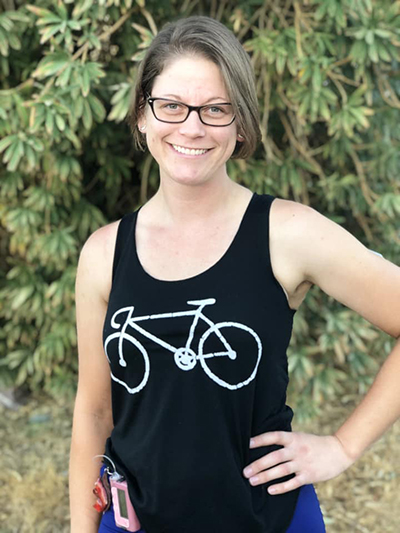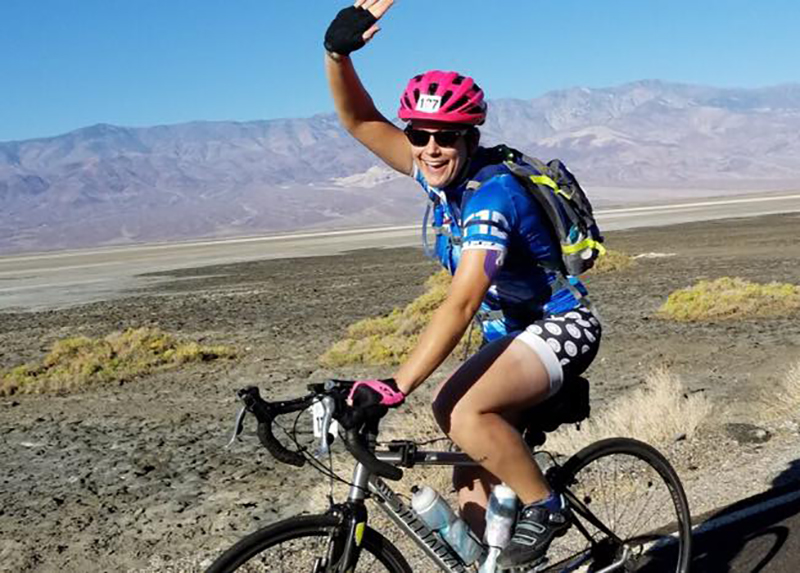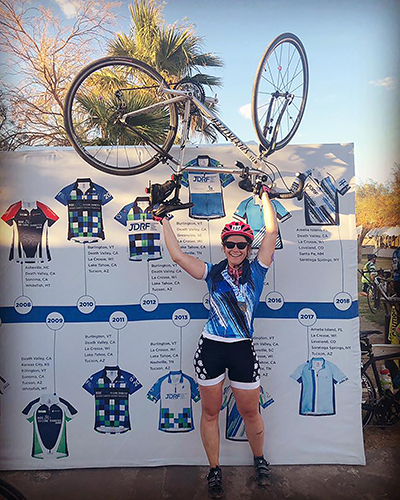One on 1 with a JDRF Rider
Welcome to JDRF Bay Area’s blog, One on 1, a series of interviews with people who live with type 1 diabetes (T1D). Members of the community talk about how T1D affects them, how they manage it, and what they have accomplished despite it. Today we talk with Annette Chmielewski, Pediatric Diabetes Educator at Stanford Children’s Health, and JDRF Ride to Cure Diabetes participant.
JDRF Bay Area: When were you diagnosed with T1D and what was it like for you at the time?
Annette: I was diagnosed at age 6, just eight days after my birthday. I don’t remember much before T1D like others might remember if they were diagnosed a little older. I was hospitalized for 10 days while my family received training. I was quite sick when I was diagnosed and recovered after a couple days, but my mom also refused to let me get discharged before she felt comfortable caring for a newly diagnosed young child with T1D. I recall having to eat snacks at very specific times of day (because of the NPH and Regular insulin action time). My mom went to the school every year to train the teachers about high and low blood sugar, how to give insulin or treat a low, and review new 504 Plan updates. My school had a full time RN on site who helped me with my blood sugar checks and insulin doses. Things were much different 10 or 20 years ago when it came to T1D management. Insulin pumps weren’t widely used at that time, and sensors weren’t even around. My initial experiences after diagnosis included meters that took 2 minutes, lancet devices that looked like a guillotine (literally), and preparing ahead of time for school, field trips, and sleepovers. I was fortunate to be diagnosed after meters were available and after the analog insulin was on the market, and we also didn’t have to sharpen or boil syringes with the ability to use syringes one time.
JDRF Bay Area: How has your outlook about the disease evolved over the years?
 Annette: I have a logical and realistic approach to diabetes, for myself and for others. I’ve been “playing the game” for long enough to know there is no such thing as perfection, and that I do the best I can with the tools and resources I have in front of me. I was never told I couldn’t do something simply because I have T1D. My mom never discouraged me from playing on the basketball team, running for the track team, playing in the band, going on sleepovers, participating in school parties, etc. I was never told I can’t go to college, get married, or have kids. My mom’s a fighter, and I think her resilience in learning what she needed to do for me wore off on me over the years and has lead me to where I am today as an RD and CDE in pediatric diabetes. She taught me to be prepared for so many different situations when it came to my diabetes. BUT, there was so much I didn’t know about diabetes management when I got into graduate school and was learning about nutrition. I learned even more about T1D management when I started volunteering at camp as a healthcare professional and understood why insulin was adjusted at certain times of day for food or correction doses. I grew up in South Bend, IN, and the closest diabetes clinic to us was in Chicago or in Indianapolis. My mom worked full time, and raised 3 other kids on her own and didn’t have time to travel to either of these locations. She and my pediatrician (who had recently graduated when I was diagnosed in 1991) learned about T1D together and figured out how to care for me and adjust doses when it was needed. I went to his office every 3 months for regular follow up care and diabetes check-ups. I do feel that had I been seen in a pediatric diabetes clinic I would have learned more about insulin dose adjustments and transition from child to adult diabetes care.
Annette: I have a logical and realistic approach to diabetes, for myself and for others. I’ve been “playing the game” for long enough to know there is no such thing as perfection, and that I do the best I can with the tools and resources I have in front of me. I was never told I couldn’t do something simply because I have T1D. My mom never discouraged me from playing on the basketball team, running for the track team, playing in the band, going on sleepovers, participating in school parties, etc. I was never told I can’t go to college, get married, or have kids. My mom’s a fighter, and I think her resilience in learning what she needed to do for me wore off on me over the years and has lead me to where I am today as an RD and CDE in pediatric diabetes. She taught me to be prepared for so many different situations when it came to my diabetes. BUT, there was so much I didn’t know about diabetes management when I got into graduate school and was learning about nutrition. I learned even more about T1D management when I started volunteering at camp as a healthcare professional and understood why insulin was adjusted at certain times of day for food or correction doses. I grew up in South Bend, IN, and the closest diabetes clinic to us was in Chicago or in Indianapolis. My mom worked full time, and raised 3 other kids on her own and didn’t have time to travel to either of these locations. She and my pediatrician (who had recently graduated when I was diagnosed in 1991) learned about T1D together and figured out how to care for me and adjust doses when it was needed. I went to his office every 3 months for regular follow up care and diabetes check-ups. I do feel that had I been seen in a pediatric diabetes clinic I would have learned more about insulin dose adjustments and transition from child to adult diabetes care.
JDRF Bay Area: You are a regular participant in the JDRF Ride to Cure Diabetes. How do you manage your T1D during your trainings and rides?
Annette:
I have been using the DIY Loop system for 2 years now with an old Medtronic pump, Dexcom CGM, both of which are connected via RileyLink and used on the Loop app on my phone. I have a preset temp target BG of 150-160 for “cycling” and I try and put that temp target on a few hours before I ride home after work (takes effort to remember), or as soon as I wake up on the weekends before a long ride. I’ve just gotten back into training for this year’s Sonoma Ride in the last 4-6 weeks. My weekday rides home from work are anywhere from 16-20 miles two or three days a week, or about two hour’s door to door, and 300-1100 feet of elevation change. My weekend rides on Saturday’s have gotten up to 40 miles so far, and will continue to increase over the next few months (increasing 5-10 miles each week) with a goal of reaching 80 miles a few weeks before the ride in August. I will also try and get a smaller 10-20 mile ride in on Sunday’s just to keep my legs moving.
I always have snacks and low supplies on me no matter where I go. Low supplies include glucose tabs or powder, shot blocks and gels. I also have one water bottle with water, and another one filled with 4 scoops (40gm carb) of electrolyte powder for weekday rides, or 5 scoops in both water bottles for long weekend rides (>50 miles). For long weekend rides I also have a 2L camelback of water. Snacks include things like protein bars (Pro Bars), fruit (fresh or dried), almond butter sandwich, chips/crackers, and jerky. It’s not uncommon for me to go low (or almost low) within the first 60-90 minutes of riding and I will stop to make sure I don’t drop further by eating something. During my training rides last summer my Loop system would limit how much basal insulin during my rides, and because of this I frequently would end up with some ketones (also partly due to ketosis from endurance training) on longer rides >50 miles. I was able to combat the ketones with insulin, water, and food. I also found that within 30 minutes of me getting off my bike at the end of the day I needed to turn off my temp target, and bolus 1-2 units because my blood sugar would spike from the low 100’s to mid-200’s in a very short time period. I often bolused for half the carbs that I ate on breaks during long training rides so that I not only had carbs on board, but also insulin on board too. Loop has helped me tremendously with being able to sleep at night, and without it I’m sure I wouldn’t have had the ability to ride and train the way I did last year.
JDRF Bay Area: What advice do you have for new riders with T1D getting ready to train for the JDRF Ride?
Here is my advice:
1) bring lots of water, snacks and low supplies,
2) plan out your route ahead of time,
3) know where bathrooms and water stops are along your ride route,
4) invest in clipless pedals, bike shoes, bike shorts/pants, and bike tops,
5) bring a meter even if you’re using CGM,
6) bring a syringe in case you need to give a manual insulin dose,
7) attend the JDRF group rides as often as possible,
8) try and find buddies to ride with or go on the group rides with you (even if they’re not signed up for the ride),
9) bring a battery pack and a charging cord for your phone just in case you need to charge,
10) connect/follow people on Strava (or other activity app) to gain inspiration from others physical activity achievements,
11) do that hill climb that is the most daunting at least once before the big ride day – it won’t be fun but it will help,
12) continue sending emails or posting on social media about your training accomplishments and fundraising goals (you never know who will end up donating to you that is somehow connected to the community),
13) get your bike fitted to your body at the local bike shop,
14) if your saddle hurts you after riding on it for 10 miles – get a new saddle (it’s worth the money),
15) invest in the saddle cream too (it’s cheap, and it helps your skin),
16) follow a training plan and keep a countdown of how many weeks are left to ride day,
17) get your bike tuned up at least once a year, and ask to do a mini tune up a couple weeks before the ride day,
18) apply and reapply sunscreen often (you’ll still end up with the most ridiculous tan lines ever, but at least you won’t get burned),
19) definitely have lots of fun on the training rides, and know that it’s OK to not finish the full century ride. Signing up for a fundraising ride is hard, and it takes a lot of work to raise the money and train at the same time.
JDRF Bay Area: What would a cure mean for you?
Annette: Overall, a cure would be great, and it would mean having to do a lot less preparation in life. My backpack/purse/luggage would be much lighter, my bank account and retirement fund would have more money in it, my apartment and refrigerator would have more space in it, and my brain would have more capacity to think about other things besides diabetes. I would always have the ability to have a full night’s sleep without CGM alarms waking me up at 2 am. I wouldn’t get as angry or upset with pharmaceutical companies or insurance plans for what is or isn’t covered for diabetes supplies, or what kind of prior authorization needs to be done for a patient in clinic because the plan doesn’t cover the preferred medication. I honestly have no idea what I would do with the extra brain space if a cure was found for T1D. A cure would also mean losing a part of my T1D community. Our T1D community is so vast, and I’ve met hundreds if not thousands of people living with T1D in my 28 years of living with it at different events and camps. While I wouldn’t lose these friends and family if a cure was found, I wouldn’t get to meet all the new and amazing people in this wonderful community.
JDRF Ride isn’t just a bike ride: it’s an experience where hundreds of riders come together from all over the world to make new friendships, enjoy the unparalleled camaraderie of the Ride community and raise money to help end T1D. The 2019 JDRF Ride is taking place in five destinations around the United States this fall, including Sonoma, CA from August 22-25. Learn more and register at ride.jdrf.org.

